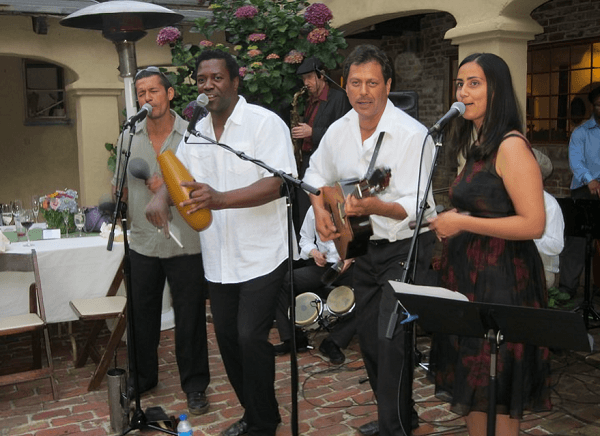| DIRECTORY OF NIGHTCLUBS | ||
Cuban music has managed to conquer so many hearts around the world that even many who were not born on the island have come to feel a great fascination for it. Such is the case of the bandleader and leader of Los Boleros Latin Band, Rudy Furlan, with whom we were able to talk for a few minutes about his career and his band.

Although Rudy was born in Guatemala, he moved to the United States when he was just three months old and has lived in the country ever since. His parents loved music and having parties at home, where various members of the family brought out guitars and broke into song to lighten the mood.
Most of his parents’ friends loved to sing boleros and the Latin classics of the time, which Rudy found pleasant and enjoyed musical activities of the adults around him to the point that he wanted to participate in those impromptu gigs within his means.
Soon after, he started taking guitar lessons at the age of nine, but it was at 16 that he started to take music more seriously and realized that he wanted to play the genres his parents always listened to such as bolero, cumbia, Cuban son, danzón, among others. Only drawback he found was that he could not find boys his age who wanted to play that kind of music, added to the fact that the communication possibilities that we enjoy today did not exist.
So, Rudy had no choice but to start forming small bands with kids who lived on his block and play rock and other local genres that were normally played back then. However, this whole situation changed when he placed an ad on Craigslist (online classified company). That is when he finally managed to get the people he needed to play what he finally wanted to play and how he wanted to play it.

Rudy finally fulfilled his dream of playing his parents’ favorite music as an adult and managed to recruit a group which he named Los Boleros Latin Band. The artist chose this name as a tribute to the genre he liked to listen to since his childhood, plus he likes how the name sounds.
In the early 2000s, he set up the band’s website to have an internet presence, which was not very common for Latin bands in Northern California in those years. There was so much rock and soul in that area, but Latin music did not have the boom that it has acquired today.
Practically from day one, they managed to have a lot of work in many events, which led several talented musicians to contact Rudy to work with him. One of them is vocalist Felix Samuel, who comes from Cuba and joined Los Boleros Latin Band in 2009. Felix comes from a family of professional musicians, so it was easy for him to integrate into his family’s craft and exercise it with the same talent and momentum as his relatives.
Something interesting to say about Samuel is that his talent began getting noticed, so he was recruited by an HBO producer to soundtrack the film ‘‘Hemingway & Gellhorn’’ with Nicole Kidman and Clive Owen.
Another important member of the band is Zareen Tangerine, who is also a vocalist in the group and joined it in 2000, making her one of the first to join Los Boleros Latin Band.
Another fundamental part of the band is David Somers, who is currently the group’s saxophonist, although he also plays the flute to perfection.
Among other members, we can also mention bassist David Pinto, percussionist Dominic Cabrera and Oswaldo Carvajal, who also plays for La Moderna Tradición.

A few years ago, Rudy bought an album by Buena Vista Social Club, which he says changed his life completely and made him change direction in terms of the music. He listened to the material every day for months, to the point that he even memorized the songs and started playing them with his guitar.
When forming Los Boleros Latin Band, his musicians played many songs from that album and other great artists such as Eliades Ochoa, Ibrahim Ferrer, Compay Segundo, Omar Portuando and many others.
Those already mentioned were some of the greatest inspirations Rudy and the members of the band had for their project, this being the vision with which the artist wants to go on through time as far as possible.
Read also: Producer, composer, and guitarist Oscar Almonte innovates with Dominican music
North America / USA / New York
En el nombre de Salomé is a playwriting written by Marco Antonio Rodríguez and directed by José Zayas based on the fiction novel In the name of Salomé by Julia Álvarez, a history that presents the life of the patriotic poet and Dominican political activist, Salomé Ureña and her youngest daughter, Camila Salomé Henríquez Ureña. Two ladies that extolled the rights of women in XIX and XX centuries.
Salomé Ureña Díaz was a feminist poet during the most important years of Independence of the Dominican Republic, which became independent from Haiti and then returned to be the Colony of Spain for a time for their protection, hence the famous poem by Ureña “A la Patria” ” Salomé also founded the first university for women in the Caribbean country with the help of her husband, Francisco Henríquez y Carvajal, who years later was president of that nation.

By the other hand, Camila Henriquez Ureña was the youngest of her intellectual children, she was a respected educator of Spanish in the United States, lecturer in Latin America, co-founder of one of the main cultural feminist associations in Cuba, obtained a PhD in that Afro Caribbean country, participated in the restructuring of University of the Havana and ended up teaching in her homeland..
This fascinating novel published in 2000, captivated the attention of the director José Zayas, who decided together with the executive director of the Repertorio Español (Theater Company in Spanish famous in New York) to put it on stage.

Both decided that Marco Antonio Rodríguez, a New Yorker with Dominican roots, was the ideal playwright for this adaptation since all his masterpieces have been of total pleasure to the audience. “I was not familiar with Salome; she was a great poet. I knew about her poetry, but I was not very informed about her, and in reality that turned out to be something very positive. It allowed me to undertake the work not as if I were writing about an icon, but in order to find her humanity”, said Rodriguez for an American media.
This writer, producer, actor and director of Latin origin modernized the dramatic play venturing elements of humor as the creation of the character “Sylvestre”, who is a naive man, which is not accepted neither in Haiti nor in the Dominican Republic, so in the scenes of conversation with “Camila” speaks in a colloquial regionalist language, which produces in the audience, acceptance, identification and laughter. Rodriguez explains that his main objective in carrying out this work was to represent the Latino in other facets and not as usual (linked to drug trafficking or other problems), he wanted to change the stereotype of Latin in dramaturgies and films.
“I’m sure they are successful … but we have other stories to share, another psychology to explore, and other issues with which our communities identify.”

Zaya and Marcos made a perfect duet for the creative realization of En Nombre de Salomé. Together, they analyzed every detail of the scenes and characters, recreated a part of the Dominican culture and highlighted the Caribbean artistic talent that according to Zaya is still scarce in the theater.

For the author Julia Álvarez, poet, novelist, and American essayist of Dominican descent, it was a pleasant impression to see the dramaturgy in the Repertorio Español. “It is so rewarding when an artist sees that her play has inspired another artist and that through that artist the word spreads and we reach more and more people … It is a way to spread the stories that are important to our history and culture … Especially at times like this, when so many in the Latino community feel harassed, unwanted and undervalued”. This playwriting, the last October, was awarded with four HOLA (Hispanic Organization of Latino Actors) Awards, including: Outstanding Achievement in Dramaturgy and Outstanding Production of the Year.
En el Nombre de Salomé Next performances:
Location: 138 East 27th Street, New York, NY 10016
To get more information about EN EL NOMBRE DE SALOMÉ, please visit their website http://www.marcoantoniorodriguez.com/
To the motherland
Tear, my homeland, the mantle that vilely, on your shoulders put the barbaric cruelty; already raises the bloody forehead from the dust, and sings the holy hymn of union and freedom.
Get up to gird yourself with the purple of glory, oh you, the world’s favorite of Columbus! Your sovereign rank dispute history, demand your laurel and your coat of arms from fame.
And ask your children, called to holy union, to carve you a grandiose pedestal of virtues, to affirm forever the powerful plant, showing the nations your immortal title.
And let, beloved country, let my hymns of pleasure mix with yours in the sonorous wind; Allow me to celebrate your joy and your contentment, as I regretted with you your bitter suffering.
I saw your own children yoking you to the iron yoke, making you an instrument of their cruel revenge; for a scepter they put the executioner’s ax for you, and funereal cypresses formed your canopy.
And then you looked at them outlaws, wandering, wandering tearful foreign beaches; and sad and downcast dying eyes I saw you return to heaven tired of crying.
You know how many times with your unfortunate pain I wept for your misfortune, I wept for your destruction, just as the daughters of Zion once wept for the ruin and havoc of its walls.
And you know that, like them, I hung from your palm groves the harp with which I wanted to sing your facts, because when I watched your blood flow relentlessly to the seas I couldn’t even prelude a chord sound.
But today that it seems you are reborn to another life, with holy rejoicing I take down my lute, to tell the world, if it judged you defeated, that, phoenix, you resurrect with new youth;
that you already hold the standard as the scepter of the free and your mother-of-pearl and sapphire sky as your canopy, and you go with progress, which flies to illuminate you, in pursuit of the bright future that flatters you;
that now your new children embrace each other like brothers, and swear to restore your dignity to your anguish, and among them there are neither serfs nor tyrants, and peace and good give us union and freedom.
O idolized country! Girded with high glory, prepare to be queen of the world of Columbus: your sovereign rank already guards history, fame presents you with your laurel and your coat of arms.
Salome Urena (1874)
